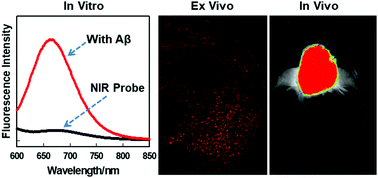Versatile fluorescent probes for near-infrared imaging of amyloid-β species in Alzheimer's disease mouse model
Abstract
The self-aggregation of amyloid-β peptides into soluble oligomers and then into insoluble fibril-associated amyloid plaques is a key event in the progression of Alzheimer's disease (AD). The imaging of Aβ aggregates in the brain is a powerful and practical approach for the diagnosis and progression monitoring of AD and the evaluation of the effectiveness of novel therapies for this devastating disease. Near-infrared (NIR) imaging is a sensitive and noninvasive method to detect and visualize Aβ aggregates in vivo because of its good penetration depth and low autofluorescence of biological substances. In this article, we comprehensively reviewed the recent progresses made in the development of molecular NIR fluorescent probes for Aβ detection and imaging in vivo with a particular emphasis on the design strategies, optical characteristics, Aβ-binding abilities and potential applications in AD mouse models.

- This article is part of the themed collection: Recent Review Articles


 Please wait while we load your content...
Please wait while we load your content...